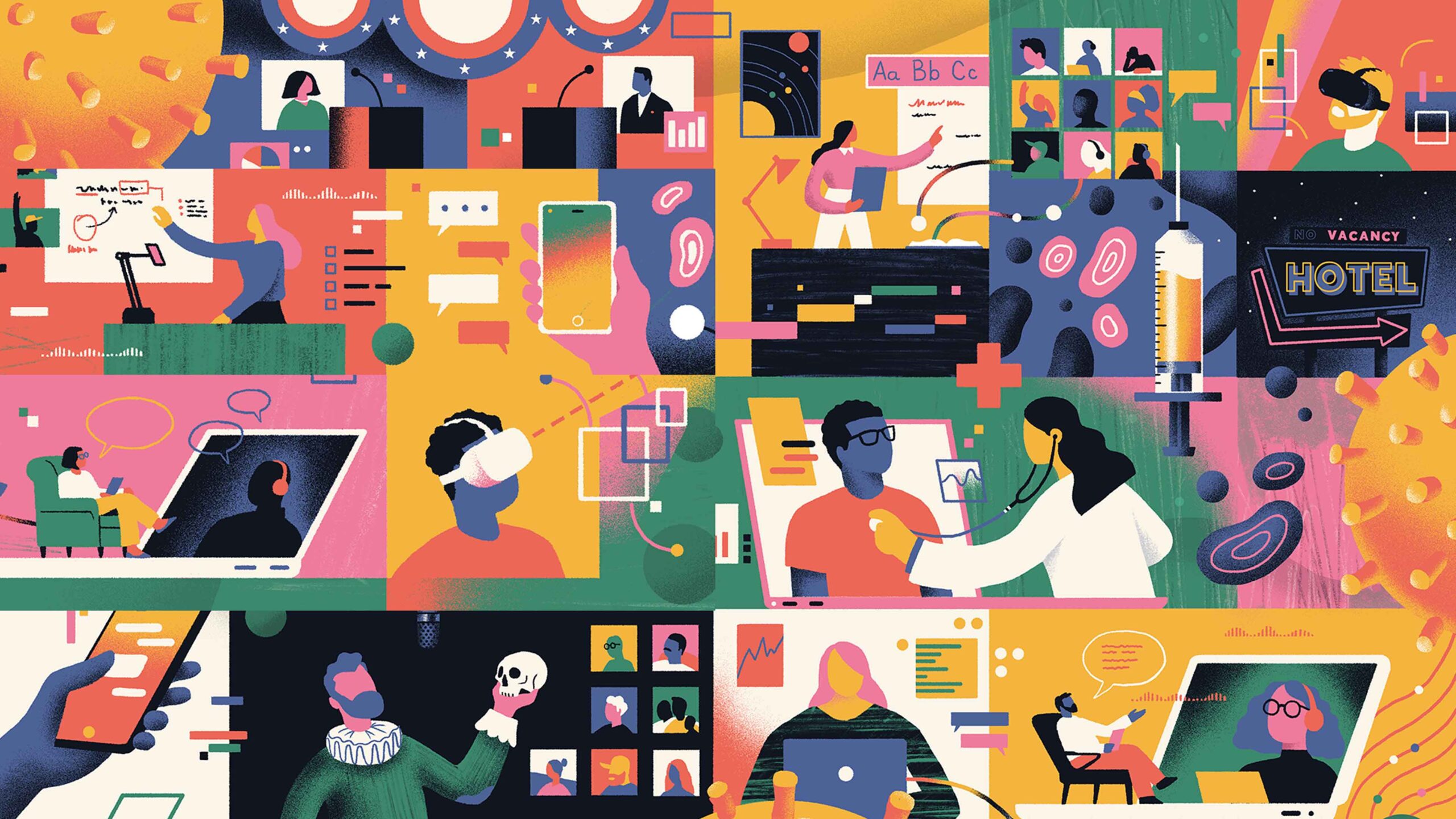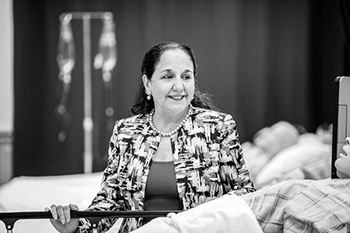Aftershocks of a Pandemic

What will post-pandemic life look like? How will industries change? (Illustration: Matt Chinworth)
The New ‘New Normal’
How has COVID-19 changed the world? In many ways, it’s too soon to tell. But while there have been major events throughout history that have defined the times and altered the future, few can rival the global impact struck by COVID-19. Looking to the future, FDU Magazine asked some of the University’s leading experts in key fields to share their thoughts on what has changed and what may come next.
Nursing and Health Care
Clinical Assistant Professor of Nursing and Associate Director of the Undergraduate Nursing Program

Sylvia Colon Cabassa (Photo: Bill Cardoni)
The arrival of the novel coronavirus in 2019 caused an ongoing international health care crisis, spurring lockdowns and claiming millions of lives. The Centers for Disease Control and Prevention (CDC) and the World Health Organization (WHO) are continuously working to provide a comprehensive understanding of the virus’ epidemiology and how it spreads from individual to individual.
Nearly a year in, there is still a lot to learn about COVID-19.
Innovative and safe health care options are available, but it will take time for patients and the medical community to fully embrace these changes. In an effort to prevent patients from foregoing health care and skipping appointments, telehealth has become the new norm in care. Unfortunately, with virtual health care, personal protective equipment and newly developed vaccines — all vital and potentially expensive elements to curbing COVID-19 — the economic inequities that already plague health care will continue.
Transformation of health care post-COVID-19 is difficult to predict because so many uncertainties about the virus remain. Certainly, there are more medications available to date to control COVID-19, and soon there will be widespread vaccinations to curb the spread of the virus. But it’s the wearing of masks and eye coverings, maintaining of social distancing, avoiding large social gatherings and keeping spaces sanitized that will be the new norm for a long while before there is adequate control of the global pandemic.
Testing for the virus and its antibodies remains confusing, giving some individuals a false sense of security. For instance, a positive antibody test result does not mean full and lifelong immunity, and a negative coronavirus test result just means the person tested is negative today and still can test positive tomorrow.
Managing the spread of COVID-19 remains challenging, having been affected by politics, economics and individual beliefs. Hospitals are overwhelmed and functioning at capacity. The coronavirus currently infects individuals of all ages, with or without comorbid conditions.
And so for now, protocols including stay-home orders, disease surveillance, contact tracing and the use of personal protective equipment are still the best course to stem the tide of the pandemic.
The Arts
Director of the School of the Arts

Todd Rosen
Rarely in modern history have we witnessed an industry so distressed by loss of jobs and by closure of venues, including theaters, performance spaces, film and animation studios and galleries.
Still, artists and arts organizations have demonstrated an uncanny ability to adapt during these challenging times. For example, FDU’s neighbors at the Morris Museum have turned their elevated parking deck into an outdoor concert space with eight-feet-by-eight-feet blocks to accommodate socially distanced patrons. Film and television production has resumed last fall with safety protocols in place, which include regular COVID-19 testing. Most theater productions, including the FDU theater arts program’s productions, are or have been streaming online. Streaming services, like Hulu and Netflix, have become popular for film releases, too, as movie theaters remain closed or open only at reduced capacity.
And yet, despite these pivots, it is painfully clear there is a long road of recovery ahead. Broadway remains closed until May 2021 at the earliest, and many museums have reopened at just 25 percent capacity.
The resolve of artists, administrators and audiences to build back bigger, better and, hopefully, in a more equitable manner is steadfast.
Arts are vital to our country’s economic health. According to the nonprofit Americans for the Arts, the arts and culture sector is a $730-billion industry, representing 4.2 percent of the nation’s gross domestic product — a larger share of the economy than transportation, tourism and agriculture.
The arts are more than just an economic driver, of course. They enrich nearly every facet of daily life — unifying communities, providing outlets for creative expression and improving students’ overall academic performance and well-being. The arts play a vital role here at FDU. For example, more students on the Florham Campus participate in the arts (as arts majors, minors or in weekly activities like chorus or band) than play team sports. We crave the content, shared experience and opportunity for reflection and civil discourse the arts brings to our lives now more than ever. As arts venues begin to reopen and recover, I would strongly recommend fighting for the arts and showing up for them any way you can.
Entrepreneurship
Executive Director of the Rothman Institute of Innovation and Entrepreneurship

Dale Caldwell
The COVID-19 pandemic has radically changed small businesses and the importance of entrepreneurship. Large businesses (other than retail) have survived, and even thrived, during this crisis. But never before have so many small enterprises gone out of business because of government mandates. The closure of these businesses has led to record unemployment and had a devastating effect on urban communities.
Ironically, the extensive unemployment caused by the closing of small businesses and large retail businesses has led to an increased interest in entrepreneurship. People are realizing that long-term jobs with a comfortable pension have gone the way of the dinosaur. The only option for many people is to either work for an entrepreneur or become an entrepreneur.
Government has never been more important to the future of entrepreneurship and small business. The time to invest in entrepreneurship and small business is now. If the federal government continues to provide incentives that benefit large businesses at the expense of small businesses, unemployment will continue to be high and the real economy will suffer.
People have been fooled into thinking the economy is good because the stock market is up. Unfortunately, how the Dow Jones Industrial Average, Nasdaq and the S&P 500 do has very little correlation with national employment. If federal policies stay the same, the stock market will continue to do well. However, the economy of average households will suffer greatly.
In contrast, if the federal government implements programs to provide financial support to entrepreneurs and offers tax incentives to small business investors, long-term employment will increase, and the innovation economy will help the United States and other countries flourish.
Government and Politics
Professor of Government and Politics

Bruce Peabody (Photo: Dan Landau)
So far, the U.S. government’s response to COVID-19 has been mostly reactive and uncoordinated. With some notable exceptions, leaders have depicted the pandemic as a “once-in-a-century” crisis, rather than a stress test of the health care system.
At the moment, it’s hard to say that health policy has irrevocably changed.
In the business and professional world, COVID-19 is prompting executives and managers to take a hard look at shared office space, the value of face time and measures of productivity. Some of these impulses are coursing through government, as well. Many court systems, for example, are finding advantages to online proceedings — they can save involved parties time and money by reducing travel and waiting (which also lowers attorney fees).
But the old adage that “all politics is local” reminds us that face-to-face encounters still matter. The post-mortem on the 2020 presidential election, and the different strategies of President Joe Biden and former President Donald Trump, may reinforce that idea.
Perhaps the biggest enduring impact of COVID-19 on American politics and government concerns people’s lived experiences and how that frames their votes. Some pundits are relabeling Generation Z, those born in the late 1990s and early 2000s, as Generation Zoom, reflecting their forced transition to online learning and socializing. These young voters have come of age in an environment marked by understandable anxiety about politics, economic futures, and now, a worldwide disease that has upended their education, their work and their relationships.
In the past, government missteps and misdeeds have helped to shape voter attitudes (think about the impact of the Vietnam War). For Generation Zoom, the combination of hyper-partisanship, economic turmoil and a mismanaged deadly virus could decisively imprint their voting decisions — and the outcomes of elections — for decades.
Hospitality
Associate Professor of Hospitality and Tourism Management and Director of the International School of Hospitality, Sports, and Tourism Management

John Niser
Travel restrictions and precautionary measures to thwart the pandemic significantly reduced and severely disrupted the hospitality sector. Industry analysts do not expect a significant recovery before 2022.
The pandemic struck when room supply hit an all-time high in 2019 and when demand was not expected to grow in 2020. The sudden drop in demand caused by the pandemic immediately affected hotels, which typically collect payment after services are rendered. Therefore, these properties bear most fixed expenses whether a room is occupied or not, making matters worse in this case.
Normally, this industry is affected by weather, seasons, business and travel patterns, but never running completely dry (with the exception of markets hit by hurricanes or wars). In this respect, the pandemic was and is a perfect storm scenario. By July 2020, the industry had registered a negative gross operating profit per available room (GOPAR) for four consecutive months. The current average occupancy levels, hovering in the 20-percent-range, are not sustainable.
Jobs and real-estate values are tied to the health of hotels and restaurants, and society counts on this industry to support mobility and provide spaces for social and business interactions. Business travel constitutes the largest and most profitable source of revenue for this sector, which most specialists predict will be the last to recover.
The pandemic has forced businesses to rely on remote work, changing communication channels within organizations and with clients. Cost savings in work practices, travel and real estate might be here to stay, which could negatively impact hotels, travel and restaurants in the long term, or at the very least, herald important changes in the sector.
In the meantime, property owners, management companies and brands are making decisions to permanently close properties or to lay off staff. Large companies are rebranding to reduce overhead and sell off real estate.
These short-term strategies will have long-term effects on the travel-business ecosystem. Soft brands, which cost less to operate, may be able to strengthen their businesses more than big legacy brands. Larger brands might enjoy more consumer confidence, making them more resilient.
After the pandemic subsides, hospitality will still be there to meet and to serve essential human needs, but the actors and services will have inevitably changed.
Education
Professor of Education and Director of the Peter Sammartino School of Education

Vicki Cohen
As the COVID-19 pandemic spread across the world, schools closed, children stayed home, and caregivers became responsible for overseeing education. With social distancing impossible in most traditional classrooms, most schools in New Jersey implemented remote learning last fall, with hybrid options for those students who wanted or needed in-person instruction. This has brought forth a series of issues that all schools — from prekindergarten through higher education — need to address:
Educational Equity — How do schools and educators ensure that all students have the devices and connectivity to learn appropriately? Is the home environment conducive to learning? In the future, how can equity be a lens for reframing how we think about schools and instruction?
Opportunity Gaps — Young children, especially in prekindergarten to second grade, are at great risk of being left behind during remote learning. Students with disabilities also need personal attention and accommodations. Caregivers must monitor and guide the learning process of vulnerable populations. Schools need to invest in support for families and interventions to accommodate students in need.
Professional Development — Teachers need devices and the bandwidth to connect with their students. They also need the pedagogical skills to use best practices and follow current trends while teaching remotely. Delivering content and engaging students of all ages and backgrounds is essential.
Student Teachers — It has been increasingly difficult to place student teachers into clinical environments during remote/hybrid learning. FDU’s Peter Sammartino School of Education has seen more than half of its teaching candidates rejected from clinical experiences in local schools as they grapple with COVID-19 protocols. Many teaching candidates are unable to complete New Jersey teaching licensure requirements because of the pandemic. Schools must commit to training and to supporting teaching candidates by providing them with opportunities to learn how to deliver instruction in a multitude of ways.
Remote learning will remain a strong option for all schools, colleges and universities even as the pandemic wanes and time moves forward. As technology evolves and instructors and students become more accustomed to using Zoom, educators will continue to innovate, offering high levels of both in-person and remote instruction.
Mental Health
Director of the Center for Psychological Services

Stefanie Ulrich
More than 10 million Americans have been infected with COVID-19, but virtually everyone has and will feel its impact emotionally.
While some are grieving the death of a loved one, people everywhere are dealing with loss, whether it be over employment, social support, health, security, privacy or just a way of life. Rates of anxiety, suicide, psychological distress, family violence and substance abuse are all up (Shullman, Evans & Wright, 2020).
Remote learning has replaced the daily routines and peer interactions critical to healthy child development, and children cannot access school-based support services. Parents are overburdened. Health care professionals and first responders are burned out and traumatized, not to mention in constant danger.
As the COVID-19 pandemic gives way to COVID-19 fatigue, effective coping will break down even further; unprecedented levels of stress are evident nationwide (Shullman, Evans & Wright, 2020).
The traditional systems of mental health care in the United States are becoming more overtaxed and fractured, so the American Psychological Association has called for a paradigm shift. Improved resilience and coping will need to be a primary focus to effectively support the functioning of millions of people whose stress levels are at an all-time high.
As we prepare for a post-pandemic “return to normal,” be it in months or years, providers and researchers can address the health and well-being of untold numbers of people by helping employers and educators create and maintain environments that address psychological health.
Social distancing and physical isolation provide protection from the virus, but are antithetical to psychological growth and emotional well-being, so organizational leaders will need expert help to develop innovative ways to address both.
Coping difficulties and psychological distress are ubiquitous now.
We need to capitalize on this normalization of emotional pain and a decrease in stigma associated with psychological help-seeking so we can help more of those in need of services than ever before.
Furthermore, measures taken by licensing boards and third-party payers to facilitate rapid adoption of telemedicine technology need to become permanent, allowing more people than ever before to get necessary support, regardless of geographical location.
References
Shullman, S.L., Evans, A. C., and Wright, C. V. (2020, November 11). APA Town Hall Psychology’s Role in Addressing the Nation’s ‘Perfect Storm’ of Stress. [Webinar] https://www.apa.org/members/content/town-hall-series
Communications
Professor of Communication Studies and Chairperson of the Communication Studies Department

Gary Radford
The history of human communication is dominated by technology.
The seminal “Spaceship Earth” ride at EPCOT offers visitors the opportunity to “explore the remarkable history of human communication from the Stone Age to the computer age.” The ride shows the beginnings of written communication — cave paintings, the development of the Phoenician alphabet through the creation of the printing press, the telegraph, the telephone, satellites, home computers and the internet.
It is a celebration of the means of information transmission, of how humans create and move messages and a celebration of the ever-more sophisticated means by which senders connect with receivers.
In the age of COVID-19, this has taken center stage.
How are people able to keep connected and communicating in a world in which they are required to be physically apart? How can people collaborate, teach and learn apart?
The answers lie in a newfound appreciation for and reliance on communication technologies. Zoom has become a ubiquitous part of everyday life, used for everything from family gatherings to yoga lessons.
But using Zoom is not the same as talking in person. Learning at a distance is not the same as learning in a classroom. And though researchers have studied communication technology in limited, specific situations — how best to use videoconferencing in a corporate setting or how universities can most effectively use Blackboard — life changes when the tech is used on mass scale.
Everyone has become, in effect, high-tech pen pals. What humans really want is the person, not just the message. Gathered around laptops to celebrate a family birthday, the information-transmission capabilities of Zoom work as well as they possibly can. But like the pen-pal letter, what humans crave is to be with the people, not to see high-resolution images.
Teaching courses online, faculty can organize and transmit information by sight, sound and text. But for the student sitting alone, there is always the sense that something more fundamental about the learning experience is missing.
Spaceship Earth does indeed celebrate a journey from the Stone Age to the computer age, but underneath the changes in technology, something fundamental stays the same. Once the pandemic is over, expect that people will collectively have much more profound appreciation for the “human” in “human communication.”
References
https://disneyworld.disney.go.com/attractions/epcot/spaceship-earth/